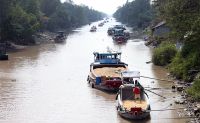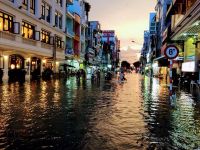
In our pages
Our contents are not the same if the three languages.
Lost meanders of the Mekong delta
The Mekong is a long, quiet river. But here and there you can find marks of history kicking the landmarks and reshaping the rivers.
Who navigates the Măng Thít river will cross the Măng Thít bridge, which 80 years after it was first built is still “Cầu mới”, or “new bridge” as all bridges are called when they are first built –the name may endure: in Paris, the “Pont neuf” is 400 years old.
canals in the delta
The Mekong delta has been the stage of large canal works since the beginning on the 19th Century, well before the French arrived. In the 1850s, the Vĩnh Tế canal, between Tân Châu and Hà Tiên on the Gulf of Siam, was an established trading route to Thailand.
You can still navigate part of the Vĩnh Tế canal today.
a steamer named Bassac
A steamer named Bassac was already trading the Mekong in the 19th Century
The story of the River Shipping Company of Cochinchina had ups and downs and more or less moral times, but one thing they had right: Their boats were well adapted to their missions, for the better part. If the early launches to Laos were quick for that time, light enough to carry through Khône, those that navigated the lower Mekong were as well fit for that area.
The delta at stake 1/4 -- Autumn floods
Every year now, the river enters Cần Thơ twice a day for a few days in the weeks following the equinox.
With their cohort of drama and the tremendous cost they let society bear, the floods may be just history in the making: they are caused by so many factors, some global and out of reach, others we can do something about. Or can we, really?
Floods in general are not necessarily bad, especially seasonal floods from a river. They bring alluvium from upstream, and deposit it in fresh strata over the land, and the days of high water usually bring much wanted life-carrying capacity to the land of a delta. Indeed, without floods there would actually be no Mekong delta. Yet, the floods bear a cost in damaged property, in health and even in lost lives.






